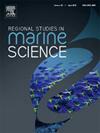Analysis of regional variation of water transparency in the Yellow Sea and East China Sea based on MODIS data
IF 2.1
4区 环境科学与生态学
Q3 ECOLOGY
引用次数: 0
Abstract
Water transparency is an important optical parameter used to interpret various properties related to water quality. We investigated regional variation in water transparency in the Yellow Sea (YS) and East China Sea (ECS) by conducting linear regression and k-means clustering analyses based on satellite-derived water transparency data and satellite products including MODIS sea surface temperatures (SSTs) and chlorophyll a concentration (Chl), colored dissolved organic matter (CDOM), and total suspended matter (TSM) levels for the period 2003–2023. Water transparency showed seasonal variation, increasing in summer and decreasing in winter, with larger seasonal extremes observed in the central YS and around Jeju Island than in coastal waters of Korea and China. Decadal variation in water transparency was significantly higher in summer and autumn than in spring and winter throughout the study area, exhibiting an increasing trend that was strongly correlated with decreasing Chl, CDOM, and TSM levels. K-means analysis resulted in the selection of five regions in the YS and ECS, among which spatial and temporal variation in water transparency were related to different regional impact factors. Coastal waters of Korea and China and the southern YS displayed a weaker increase in water transparency, which was associated mainly with Chl, followed by TSM and CDOM. In contrast, water transparency tended to increase dramatically in the central YS, where decadal variation was associated mainly with changes in TSM, followed by Chl and CDOM levels. Thus, regional variation in water transparency in the study area was dependent on local water conditions. These findings will be useful for understanding regional water quality in the study area.
求助全文
约1分钟内获得全文
求助全文
来源期刊

Regional Studies in Marine Science
Agricultural and Biological Sciences-Ecology, Evolution, Behavior and Systematics
CiteScore
3.90
自引率
4.80%
发文量
336
审稿时长
69 days
期刊介绍:
REGIONAL STUDIES IN MARINE SCIENCE will publish scientifically sound papers on regional aspects of maritime and marine resources in estuaries, coastal zones, continental shelf, the seas and oceans.
 求助内容:
求助内容: 应助结果提醒方式:
应助结果提醒方式:


